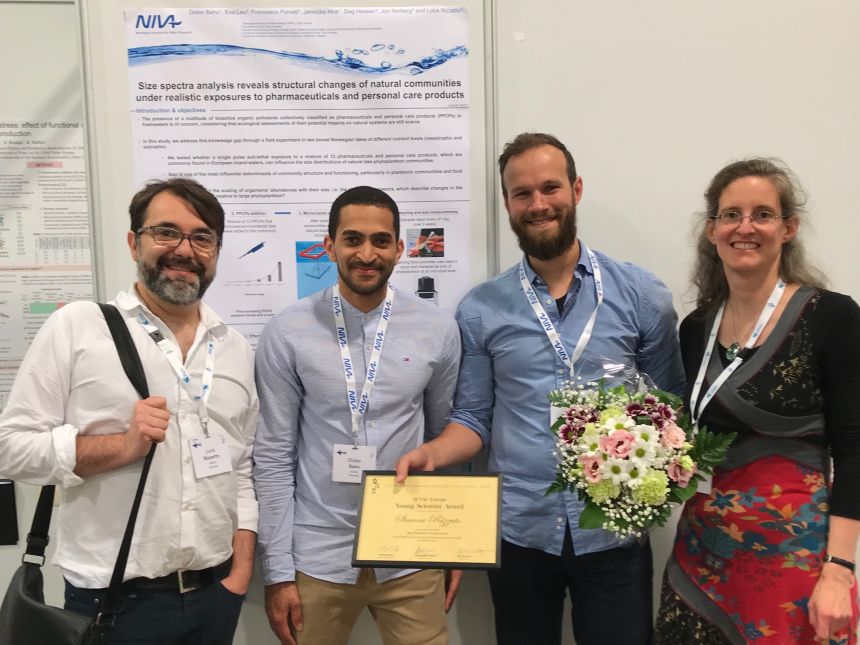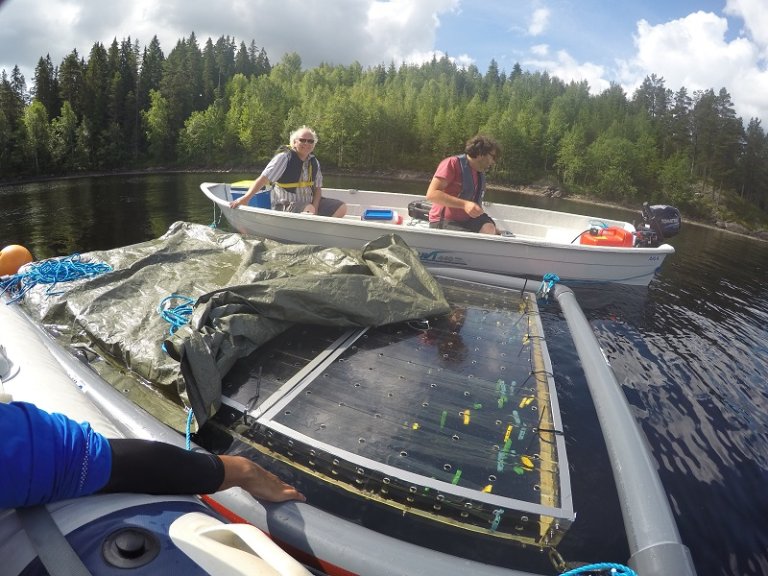
NIVA and Akvaplan-niva stand out at the SETAC meeting
The PEACE project (Pollution and Ecosystem Adaptation to Changes in the Environment) studies natural phytoplankton communities' responses to realistic exposure scenarios of environmental contaminants that are frequently found in European surface waters. Contrary to standard ecotoxicological testing with single species under controlled laboratory conditions, researchers in this project worked with natural phytoplankton communities, sometimes even in their natural environment.
The PEACE project is led jointly by NIVA and Akvaplan-niva, and is funded by the Research Council of Norway. Collaboration partners include the University of Oslo, Stockholm University and EAWAG in Switzerland.
How do ecosystems react to contaminant exposure?
- Most important for us in the PEACE project is to work towards a more realistic way of studying contaminant effects on natural ecosystems. This requires both developing new experimental methods, but also innovative approaches to analyse and interpret the data, says Eva Leu, senior scientist at Akvaplan-niva and co-leader of the PEACE project.

The scientists applied several concepts from theoretical ecology that are usually not used in the context of ecotoxicology. But the benefit from this is actually two-directional:
- Some of these theories have been lacking empirical evidence so far – which is something we can achieve now, by using specifically contaminants as stress factor, explains Leu.
Important ecological phenomena such as resilience, acclimation and adaptation play a key role in a natural system's approach towards contaminant exposure, but are notoriously difficult to address in short-term experiments. The PEACE team therefore has developed during this project innovative experimental approaches that allow including these aspects.
The overarching project question is how contaminants that are frequently found in lakes and rivers affect aquatic ecosystems.
This was the background for a first large experimental study during summer 2016, carried out simultaneously in three lakes in the vicinity of Oslo. The PEACE team investigated the response of natural phytoplankton communities towards a pulse exposure to a mixture of 12 emerging contaminants over a period of three weeks. The results show significant and lasting effects on community production and size composition at the two highest exposure levels that were applied. A first article from this experiment was published just last week.
Best Platform Presentation Award
In a second experimental study, the PEACE team studied natural phytoplankton communities that they obtained from sediments of two Swedish lakes, of which one had a long-term contamination exposure history due to its location in an agricultural catchment, whereas the other was pristine.

First results from this study were presented by PhD student Simone Rizzuto under the title "Freshwater phytoplankton community response across different historical contamination backgrounds", which won the Best Platform Presentation Award at the SETAC meeting.
- From the lake sediments, we germinated natural phytoplankton communities in the lab in the presence and absence of a common herbicide (Phase I). Afterwards, we exposed the resulting communities to five different concentrations of the same herbicide (Phase II), Eva Leu says, one of Rizzuto's supervisors.
Interesting results
The study presented by Rizzuto at SETAC is special as it addresses the ability of phytoplankton to cope with herbicide exposure on very different timescales.
- By using the 'phytoplankton seed vault' from the sediments of two lakes, we were able to integrate both evolutionary aspects of adaptation (=long-term processes involving gene mutations), and short-term acclimation (=physiological and biochemical responses on shorter timescales). Both contribute to a selection process that favours species with a higher ability to cope with chemical stress, Leu says.
Exposure of phytoplankton during the germination phase to moderate herbicide concentrations did not result in major effects.
- But really striking were the results from phase II of the experiment, when the four different communities were exposed to higher herbicide concentrations. Here, we actually found that their response was dependent primarily on their long-term contamination history. Communities originating from the agricultural catchment increased their resistance, and recovered better during phase II when they already had been exposed to herbicide during phase I. On the contrary, pristine communities became more sensitive through pre-acclimation to the herbicide, and showed a stronger negative response during phase II, probably because they were weakened already during the germination phase, and had no resilient species to select for in their genpool, explains Leu.
- These results reveal an intricate interplay of long-term adaptation and short-term acclimation and highlight the need of including also historic background contamination into assessments of ecosystems' vulnerability or recovery potential in the context of contaminant exposure, she says.
- No mainstream ecotoxicology
The SETAC award is prestigious, and the PEACE presentation won in competition with more than 100 presentations.
- What we are doing in PEACE is far from 'mainstream' ecotoxicology – and seems for the time being to be a relatively new field with a limited number of researchers active in it. But the feedback we got at SETAC, not the least from the organizers, confirms that it is therefore extra important to showcase and share these new studies that are truly working across the traditional disciplines of either ecology or ecotoxicology. We are confident that this is the way to proceed if we want to understand responses in more complex systems, Leu concludes.
The PEACE-team had a total of four presentations at the SETAC meeting in Helsinki. The project will come to an end in November 2019, and there are several more publications that are currently being prepared.